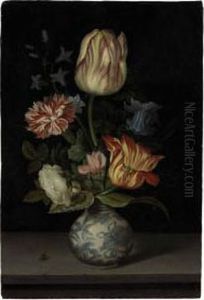Johannes Van Der Ast Paintings
Johannes van der Ast was a Dutch painter born in Middelburg in 1593, during a period known as the Dutch Golden Age, which was marked by great wealth and cultural achievement in the Netherlands. Van der Ast was known for his skill in painting still lifes, a genre that became particularly popular in the Netherlands during the 17th century. His works often included an array of objects such as flowers, fruits, and shells, and he was particularly renowned for his ability to depict these elements with a high level of detail and realism.
Van der Ast was trained by his brother-in-law, the painter Balthasar van der Ast, who was also his early influence. Balthasar was known for his still lifes and flower pieces, and Johannes adopted many of his techniques and motifs. Johannes van der Ast's own style, however, was distinguished by its finesse and the subtle handling of light and texture.
Throughout his career, van der Ast contributed to the development of the still life genre, which evolved from simple displays of objects to more complex compositions imbued with symbolism and hidden meanings. His paintings often included insects and small reptiles, which, in addition to adding a sense of life to his compositions, were also laden with symbolic significance in the context of memento mori themes – reminders of the transience of life.
Van der Ast moved to Utrecht around 1619, where he became part of a circle of artists who were pioneering the new genre of still life painting. Later, he settled in Delft by 1632, and finally moved to the city of Boskoop where he would spend the remainder of his life. His works continued to be influential, and he taught a number of students who would go on to be significant painters in their own right.
Johannes van der Ast passed away in 1657, leaving behind a legacy that would cement his place as one of the key figures in the development of Dutch still life painting. His works are characterized by their vivid colors, careful composition, and the delicate rendering of textures, which continue to be admired for their beauty and technical mastery. Today, his paintings can be found in various museums and collections around the world, attesting to his enduring appeal and importance in the history of art.
